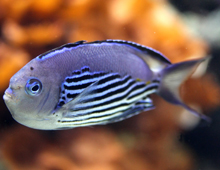Description: Watanabe’s angelfish also known as Watanabe’s lyretail angelfish, are one of the few angelfish with sexual dimorphism. Males are pale blue with eight thin, black horizontal stripes on the lower two-thirds of the body and one, horizontal orange stripe extending toward the caudal fin. Females are light blue with no stripes except a deep black vertical bar over the eyes. Both males and female have dorsal and anal fins outlined in black, but only females have a black outline on their caudal fins.
Size: Watanabe’s angelfish reach up to six inches (15 cm) in length; females are smaller than males.
Behavior: These diurnal fish are protogynous hermaphrodites – they are all born female and later in life can change to male. They are found in pairs or in harems of up to five individuals.
Diet: They feed on plankton.
Communication: Courtship and mating rituals are performed through different movements and fin gestures. Males roll over onto their side and tremble or quiver their caudal fin in front of females to entice them to mate. If successful in his demonstrations, the female will reciprocate by extending all of her fins.
Reproduction: They are pelagic spawners. After the courtship ritual is completed, the male and female swimming closely together, release gametes into the water where external fertilization
takes place. The tiny eggs float with the currents until they hatch.
Habitat/range: Watanabe’s angelfish are found in current-swept outer reef slopes and drop-offs in the western and central Pacific Ocean – Taiwan to the Tuamoto Islands, north to the Ryukyu Islands, south to New Caledonia and the Austral Islands.
Status: Listed as Least Concern on the IUCN Red List.



